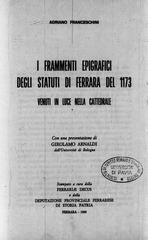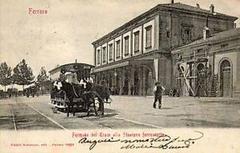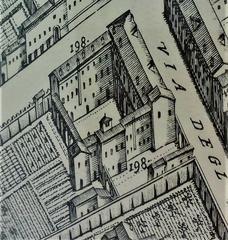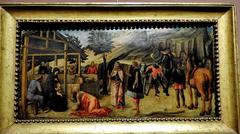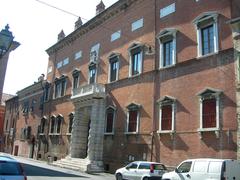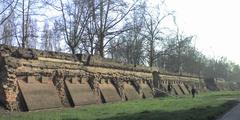Palazzo Rondinelli Visiting Hours, Tickets, and Ferrara Historical Sites Guide
Date: 03/07/2025
Introduction
Palazzo Rondinelli, set in the heart of Ferrara, Italy, is a captivating symbol of Renaissance urbanism and aristocratic life. Although overshadowed by landmarks like the Castello Estense or Palazzo dei Diamanti, its architectural elegance and rich history make it a rewarding destination for visitors eager to immerse themselves in Ferrara’s Renaissance past. This guide provides key information on visiting hours, tickets, accessibility, and nearby attractions, along with historical context and practical tips for exploring Ferrara’s vibrant cultural scene.
Table of Contents
- Historical Overview
- The Addizione Erculea and Urban Context
- Architectural Features and Community Role
- Visiting Palazzo Rondinelli
- Unique Visitor Experiences
- Nearby Attractions
- Events and Local Life
- Practical Visitor Tips
- FAQ
- Visual Resources
- Conclusion
- Sources
Historical Overview
Early Origins and Architectural Context
Built in the late 15th century, Palazzo Rondinelli exemplifies Ferrara’s transformation during the Renaissance. Commissioned under the Este family, notably Ercole I d’Este, and designed by Biagio Rossetti, the palace reflects the transition from medieval to Renaissance architectural values. Its striking 84-meter arcaded façade and covered portico were conceived to integrate with Ferrara’s broader urban vision, contributing to the Addizione Erculea—Europe’s first modern urban expansion (Museo Ferrara; Ducato Estense).
The Este Family and Renaissance Ferrara
The Este dynasty ruled Ferrara from 1242 to 1598, fostering a cultural and artistic renaissance. Through projects like the Addizione Erculea, they promoted innovative city planning and the construction of noble residences. Palazzo Rondinelli, originally built for the Stancari and Roncagalli families and later acquired by the Rondinelli Counts, became an emblematic part of this civic transformation (Ducato Estense; Catalogo Beni Culturali).
Artistic and Social Significance
Palazzo Rondinelli’s façade, portico, and proportions evoke the grandeur of ancient Roman forums, aligning with Renaissance ideals of urban beauty, order, and civic participation. The stonework by Gabriele Frisoni da Mantova, under the artistic guidance of Ercole de’ Roberti, harmonizes decorative elements with the expressive style of the Ferrara school. The palace not only served as an aristocratic residence but also played a vital role in Ferrara’s social and cultural life, hosting gatherings and participating in the city’s major events (Italyscapes; Ferrara Terra e Acqua).
Transformations and Later Uses
Following the Este dynasty’s decline, the palace underwent several changes in ownership and function. It has been known as Palazzo Zatti and housed the Istituto femminile di S. Vincenzo, demonstrating its adaptive use through Ferrara’s evolving history (Ducato Estense).
The Addizione Erculea and Urban Context
Palazzo Rondinelli is a cornerstone of the Addizione Erculea—Ferrara’s Renaissance urban expansion masterminded by Biagio Rossetti in the late 15th century. This plan established a rational grid, wide avenues, and integrated green spaces, significantly expanding the city and exemplifying modern urban planning principles (Museo Ferrara). Piazza Ariostea, where the palace is located, was conceived as a central civic space, designed for public gatherings and cultural events rather than commercial activity (Ferrara Terra e Acqua).
Architectural Features and Community Role
The palace’s defining feature is its long, arcaded portico with 22 arches and a wooden ceiling, creating a sheltered public walkway that encourages social interaction and community life (Ferrara Terra e Acqua). This architectural restraint, a hallmark of Rossetti’s style, blends functionality and elegance, reinforcing the square’s unique urban character.
Piazza Ariostea is also the stage for Ferrara’s most important annual events, including the Palio di San Giorgio—a historic pageant and series of races that animate the square with medieval tradition and community spirit (Ferrara Terra e Acqua). The square also hosts the Ferrara Summer Festival, merging contemporary music and cultural performances with Renaissance architecture (Italyscapes).
Visiting Palazzo Rondinelli
Visiting Hours and Admission
As of July 2025, Palazzo Rondinelli primarily serves as a private residence and institutional space. The exterior and its iconic portico are accessible to the public year-round, without an admission fee (FEdetails). Interior access is rare and typically limited to guided tours or special cultural events. For up-to-date information on openings and ticketed events, consult the Ducato Estense website or the Ferrara tourist office.
Accessibility
The portico is at street level and generally accessible to visitors with limited mobility. However, due to the building’s historic nature, interior spaces may have restricted accessibility. Check with local tourism offices for the latest updates on ramps, elevators, and accessible entrances.
Travel Tips
- Best Seasons: Plan your visit in spring or autumn for pleasant weather and a full calendar of events (Champion Traveler).
- Guided Tours: Book in advance for special events or group visits. The palace may be included in city passes like the MyFe Card for broader access (Mignon Travels).
- Getting There: Palazzo Rondinelli is centrally located in Piazza Ariostea, easily reached on foot, by bicycle, or via public transport. Parking is available outside the city walls (Savoring Italy).
Unique Visitor Experiences
- Guided Architectural Tours: Local guides offer insightful walking tours focusing on Ferrara’s Renaissance palaces, often including detailed explanations of Palazzo Rondinelli’s historical and architectural context (nomads-travel-guide.com).
- Cultural Events: Attend the Palio di San Giorgio or Ferrara Summer Festival in Piazza Ariostea for a vibrant community experience.
- Photography: The portico’s arches and the lively piazza are ideal for capturing the ambiance of Renaissance Ferrara.
Nearby Attractions
- Castello Estense: The Este family’s iconic moated castle, offering guided tours and panoramic views (The Crazy Tourist).
- Palazzo dei Diamanti: Renowned for its diamond-pointed façade and the National Art Gallery (Not Your Mama’s Italy).
- Casa di Ludovico Ariosto: The home of the famed Renaissance poet.
- Ferrara’s City Walls: Well-preserved Renaissance fortifications, perfect for walking or cycling (The Travel Folk).
Events and Local Life
Piazza Ariostea is a focal point for Ferrara’s public life, hosting the Palio di Ferrara each May—a lively spectacle of parades and races that brings history to life (Savoring Italy). The square is also the setting for open-air concerts, markets, and seasonal festivals, making it a dynamic community hub.
Practical Visitor Tips
Getting There and Local Transport
- Location: Piazza Ariostea 10-12, Ferrara (Ducato Estense)
- Access: Walk, cycle, or use public transport from the train station or city center. Car parking is available outside the historic core due to vehicle restrictions.
What to Bring
- Comfortable Shoes: Ferrara’s cobbled streets and porticoes invite exploration on foot or by bike.
- Camera or Smartphone: The portico and piazza are photogenic, especially in morning or late afternoon light.
- Weather-Appropriate Attire: Spring and autumn require layers; summer can be hot (Where and When).
- Tickets/ID: If attending a guided tour or special event, bring confirmation and ID.
Dining
Enjoy Ferrara’s culinary delights at nearby trattorias and bakeries, such as:
- La Compagnia (Piazza Sacrati, 32)
- Hosteria Savonarola (Piazza Savonarola, 18)
- Osteria degli Angeli (Via delle Volte, 4)
- Forno Perdonati (Via S. Romano, 108) (Browsing Italy)
Safety and Sustainability
Ferrara is a safe, walkable city, but remain vigilant for pickpockets in crowded areas (Champion Traveler). Embrace sustainable travel by using bicycles or walking and respect preservation guidelines at heritage sites (Leisure Cycle Tours).
Frequently Asked Questions (FAQ)
Q: What are Palazzo Rondinelli’s visiting hours?
A: The exterior and portico are accessible at all times. Interior tours are rare and typically coincide with special events; check official sources for updates.
Q: Is there an admission fee?
A: No fee is required to view the exterior and portico. Special tours may have fees.
Q: Are guided tours available?
A: Yes, occasionally during cultural events or by arrangement with local guides or tourism offices.
Q: Is Palazzo Rondinelli accessible for visitors with disabilities?
A: The portico is accessible at street level; interior spaces may be limited in accessibility.
Q: How do I get there?
A: Located in central Piazza Ariostea, reachable on foot, by bike, or public transport.
Visual Resources
- Interactive Map of Ferrara Historical Sites
- High-quality images of the portico and Piazza Ariostea available on local tourism sites.
Image alt tags: “Palazzo Rondinelli portico and arches,” “Piazza Ariostea with Ariosto statue and palace backdrop.”
Conclusion
Palazzo Rondinelli stands as a testament to Ferrara’s Renaissance vision—harmoniously blending architectural beauty, historical depth, and living tradition. Its arcaded façade and strategic location in Piazza Ariostea make it both a cultural landmark and a lively center of local events. Although interior access is limited, the palace’s exterior and portico provide a vivid window into Ferrara’s urban and artistic legacy. Plan your visit during spring or autumn, explore the surrounding historical sites, and take advantage of guided tours or festivals for a truly enriching experience of Ferrara’s Renaissance heritage.
For personalized itineraries and real-time updates, download the Audiala app and follow Ferrara’s tourism channels for the latest information on events and visiting opportunities.
Sources and Further Reading
- Short History of Ferrara, Corte Ducale
- Renaissance Culture in Ferrara, European Waterways
- Places to Visit in Ferrara, Italy This Way
- Addizione Erculea and Palazzo Rondinelli, Museo Ferrara
- Piazza Ariostea History and Events, Ferrara Terra e Acqua
- Ferrara Summer Festival 2025, Italyscapes
- Palazzo Rondinelli History, Ducato Estense
- Portico Details, FEdetails
- Best Time to Visit Ferrara, Champion Traveler
- Ferrara Travel Itineraries, Mignon Travels
- Ferrara Food and Culture, Savoring Italy
- Travel Guide, Browsing Italy
- Leisure Cycle Tours Blog, Ferrara Scenic Routes
- The Crazy Tourist
- Not Your Mama’s Italy
- The Travel Folk
- Where and When
